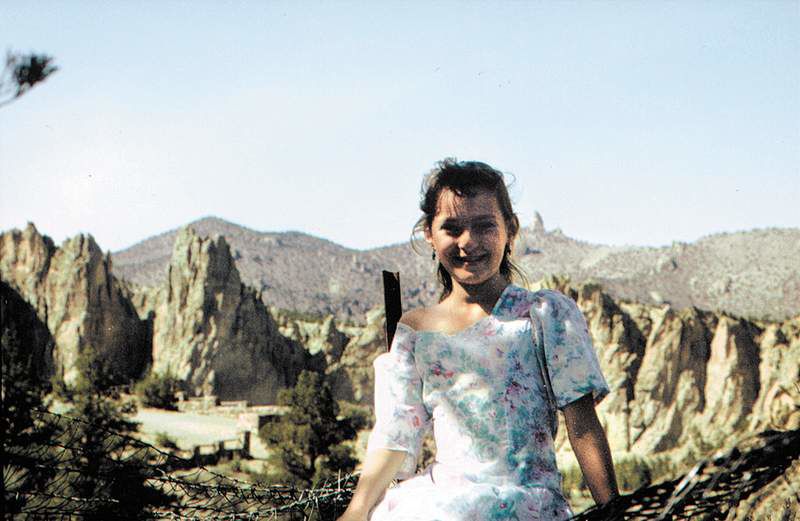Redmond woman may get new arms, thanks to a chance meeting in Chicago
Published 5:00 am Thursday, October 16, 2008

- Sarah Mues, at 14, visited Smith Rock State Park the summer before she lost her arms to pneumococcal sepsis.
When Sarah Mues was 14 years old, she came down with pneumococcal sepsis, a bacterial infection.
Doctors said Mues had hours to live. Eventually falling into a coma, she survived, but the infection had reduced blood flow to her extremities.
After about 10 days in the coma, Mues woke. Doctors told her they would have to amputate both arms around her elbows, and her toes. Initially Mues refused, but soon realized there was literally no life left in her arms.
Now, 16 years later — after a trip to Chicago and a chance encounter at a bakery — Mues, 30, is a candidate to become one of the few dozen people in the world to receive arm and hand transplants. If she qualifies, the process will likely take years, but at the end, the Redmond resident could have fully functioning arms and hands — for the first time in her adult life.
That’s something that seemed impossible after Mues came out of her coma in 1992. Her arms had gone “charcoal black,” as she put it. Once, when her hand hit the metal bedside railing, Mues heard a “ping,” as if metal had hit metal.
The amputations were brutal news for her mother, Valerie Thomas, whom she’d been visiting that Christmas. But after thinking her daughter wouldn’t survive the infection, Thomas was grateful.
“She was still alive,” Thomas said. “Her arms had died. Her toes had died. But she was still alive.”
Mues has two sons and lives mostly on disability payments. She’s found ways to get through the mundane parts of her day, but sometimes in incomplete ways.
She can brush her hair, for example, but because she can’t reach behind her head, she can’t grow it long enough to pull into a ponytail — a style she loves.
Mues is proud of what she can do and often jokes about her loss.
“They told me afterward that I would have to go to a psychologist because I would go through denial and depression,” Mues said on her way back from Pittsburgh, where she took the first steps toward the transplants. “When they told me that, I said, ‘How would I go through denial? Am I going to say, my arms are right there, you just can’t see them?’”
After the amputations, Mues underwent physical and occupational therapy. She rejected the therapist’s method of holding items. It required her to wear a wide bracelet around her arm with an attached leather strap, through which she could slide a toothbrush or spoon. Mues figured out how to hold things between her stumps, a method she uses to eat as well.
For more than 15 years, Mues lived her life and came to terms with losing her hands. She’s even begun speaking at area schools about her life.
A new story to tell
The story she tells at those schools may soon have a new ending. That became a possibility during lunch at the Chicago bakery in September. Mues had recently suffered through a difficult breakup. To help her recover, her sister Jenna took her to the Windy City for some fun. The choice of city was almost random, just a chance to go to a big city.
The sisters were eating lunch when a middle-aged man sat down at their table.
Mues, already a bit wary of men from her recent breakup, wasn’t thrilled about the interruption. The man, Ernie Manders, quickly apologized for breaking into their meal and introduced himself as a reconstructive surgeon.
“We noticed Sarah didn’t have any arms or hands,” Manders said, recalling the bakery encounter during a telephone interview. “…We saw her pick up a fork and feed herself a salad. I do hand surgery, and I’ve never seen anybody do this in my life.”
At that moment, he explained, two doctors who perform arm and hand transplants — Stefan Schneeberger and Vijay Gorantla — were attending the annual conference for the American Association of Tissue Banks in Chicago.
Schneeberger, Gorantla and Manders are colleagues at the University of Pittsburgh Medical Center.
Impressed by Mues’ ability to complete the mundane — to eat a salad, for example — Manders invited Mues to the conference.
“It was so surreal,” Mues said. “I felt like I was living in someone else’s life.”
She met the doctors the next day at the conference.
“We shook hands,” she said. “Well, he didn’t shake my hand, but I shook his.”
Within a few weeks, Mues was in Pittsburgh undergoing a round of blood tests. While there, Manders and his wife, Sandra, took Mues and her father to dinner. Manders watched in amazement — and with a bit of embarrassment — as Mues made her way through a dinner of soup and pasta. She never spilled a drop, he said.
Manders, with two hands, had to tuck a napkin into his collar to keep drops of food from staining his shirt.
“For somebody who has a problem, seeing Sarah will force you to readjust how significant a problem you really have,” Manders said. “It’s unbelievable.”
What’s next?
If the blood tests show Mues is healthy, she will move on to another round of intensive tests: CAT scans, bone marrow tests and psychological exams, among others.
One test will check her brain’s ability to move her hands. Medical staff will need to check if her brain still remembers how to, for example, wiggle a finger, she said.
If all the tests go well, Mues will have to move to Pittsburgh and wait. A suitable donor could become available at any time.
All the medical procedures are free, Mues said. But she still has to find a way to pay for her travel and living expenses while in Pittsburgh, where she could be for more than a year. Mues must be in the city to wait for the death of a donor.
Once a donor is found in the U.S., everything happens at a hyper pace. Manders compared it to ski jumping, where the athlete must stay in control to keep from falling into chaos. Once the donor’s blood stops flowing, doctors and nurses have nine hours to get to the body, draw bone marrow and amputate the arms, return to Pittsburgh and attach the limbs to Mues.
“You have everything planned,” said Manders, who will likely travel to the donor site. “You start the clock. You walk out of the hospital in the transport vehicle. There are four teams in place when you get back. You walk in the door and say, ‘Let’s get to work.’”
But for someone who Manders describes as “highly functioning,” the risk-reward equation has to be balanced. Why would Mues — who can brush her teeth, feed herself, comb her hair — risk such a grueling operation?
She doesn’t hesitate to give her answer.
“I want to give my kids a hug; I want to hold their hand; I want to feel my life,” Mues said. “I think about being able to run my fingers through my kids’ hair.”






